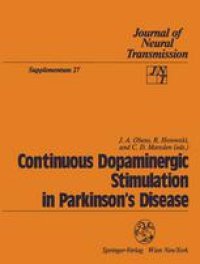
Ebook: Continuous Dopaminergic Stimulation in Parkinson’s Disease: Proceedings of the Workshop in Alicante, Spain, September 22–24, 1986
- Tags: Neurology, Psychiatry, Pharmacology/Toxicology, Neurosciences
- Series: Journal of Neural Transmission 27
- Year: 1988
- Publisher: Springer-Verlag Wien
- Edition: 1
- Language: English
- pdf
At this meeting, a number of critical groups confirmed and extended the original findings by J.A. Obeso and his colleagues. These authors found that continuous s.c. infusion of lisuride, a watersoluble dopaminergic 8- -aminoergoline with dopaminergic properties which can be injected or infused, can improve - sometimes quite considerably - motor function in severely disabled fluctuating Parkinsonian patients. The concurrent use of the peripheral dopamine antagonist domperidone attenuates or prevents side effects related to the stimulation of "peripheral" dopamine receptors, including the chemoreceptor trigger zone and some areas of the hypothalamus outside the blood-brain barrier. The clinical results discussed in this volume may not only be a basis for further improvements in our knowledge and therapeutic strategies in Parkinsonism, they point to the so far neglected importance of different ways of stimulating neurological or other systems, e.g. discontinous, oscillatory effects caused by frequent oral application vs. continuous stimulation as described here with the lisuride s.c. infusion. Similar concepts have to be discussed and investigated in neurological disorders. In this respect, this multidisciplinary meeting and its publication may offer new ideas and concepts for therapy in general, in addition to its potential application in the treatment of the complications of Parkinson's disease.
At this meeting, a number of critical groups confirmed and extended the original findings by J.A. Obeso and his colleagues. These authors found that continuous s.c. infusion of lisuride, a watersoluble dopaminergic 8- -aminoergoline with dopaminergic properties which can be injected or infused, can improve - sometimes quite considerably - motor function in severely disabled fluctuating Parkinsonian patients. The concurrent use of the peripheral dopamine antagonist domperidone attenuates or prevents side effects related to the stimulation of "peripheral" dopamine receptors, including the chemoreceptor trigger zone and some areas of the hypothalamus outside the blood-brain barrier. The clinical results discussed in this volume may not only be a basis for further improvements in our knowledge and therapeutic strategies in Parkinsonism, they point to the so far neglected importance of different ways of stimulating neurological or other systems, e.g. discontinous, oscillatory effects caused by frequent oral application vs. continuous stimulation as described here with the lisuride s.c. infusion. Similar concepts have to be discussed and investigated in neurological disorders. In this respect, this multidisciplinary meeting and its publication may offer new ideas and concepts for therapy in general, in addition to its potential application in the treatment of the complications of Parkinson's disease.